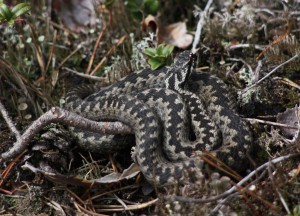Common viper
 This is a relatively small snake, with the top body length of about 75 cm and the average of 60; up north only there were encounters with vipers of up to 1 m in length. Females are somewhat larger than males. The head of the viper is clearly distinct from the neck, the snout’s tip rounded when looked at from above. The upper parts of the body are grey, black-brownish or red black-brown with the dark zigzag dorsal pattern. There is an X-shaped pattern on the head. Encounters with black adders are not rare, though there are more of them up north. In our region common vipers are fairly few. They inhabit the forest and forest-steppe zones, preferring mixed forests with glades and proper plant stand, forest edges, clearings, overgrowing burnt spots, marshes, riverbanks and lakeshores. As most snakes of the northern and moderate latitudes, the common viper is patchy in its distribution, developing swarms in places appropriate – snake loci – yet absent from vast areas completely. Placement of such snake loci in our area is determined by the spots fitting for wintering. They winter below the freeze-through soil level, at depths from 40 cm to 2 m, more often in rodent and mole holes, in rotten tree and bush tunnels, in peat cavities, given they are not filled with water, under haystacks, in big piles of rock and deep crevices in cliffs. As a rule, vipers are sedentary and live their lives in the same spot, moving within the radius of 60-100 m max. Commonly, the basis of their nutrition is mouse-like rodents and frogs throughout the entire active period, yet they divert to nestlings in the mass nesting seasons of smaller ground birds.
This is a relatively small snake, with the top body length of about 75 cm and the average of 60; up north only there were encounters with vipers of up to 1 m in length. Females are somewhat larger than males. The head of the viper is clearly distinct from the neck, the snout’s tip rounded when looked at from above. The upper parts of the body are grey, black-brownish or red black-brown with the dark zigzag dorsal pattern. There is an X-shaped pattern on the head. Encounters with black adders are not rare, though there are more of them up north. In our region common vipers are fairly few. They inhabit the forest and forest-steppe zones, preferring mixed forests with glades and proper plant stand, forest edges, clearings, overgrowing burnt spots, marshes, riverbanks and lakeshores. As most snakes of the northern and moderate latitudes, the common viper is patchy in its distribution, developing swarms in places appropriate – snake loci – yet absent from vast areas completely. Placement of such snake loci in our area is determined by the spots fitting for wintering. They winter below the freeze-through soil level, at depths from 40 cm to 2 m, more often in rodent and mole holes, in rotten tree and bush tunnels, in peat cavities, given they are not filled with water, under haystacks, in big piles of rock and deep crevices in cliffs. As a rule, vipers are sedentary and live their lives in the same spot, moving within the radius of 60-100 m max. Commonly, the basis of their nutrition is mouse-like rodents and frogs throughout the entire active period, yet they divert to nestlings in the mass nesting seasons of smaller ground birds.
On rare occasions they can prey on lizards, smaller birds and their nestlings, as well as small mammals, including new-born water-rats and muskrats. Young snakes often hunt insects.
/ * The photos at lake.peipsi.org are cross-posted from commons.wikimedia.org and are used for familiarization purposes only. No commercial use of the photos is allowed. For more information about to use the photos see the originals on commons.wikimedia.org. /


